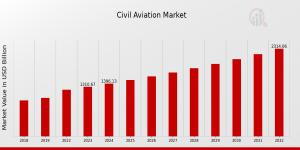Civil Aviation Market, By Aircraft Type, By Operation Type, By Flight Range, By Engine Type, By Application, By Regional
NEW YORK, NY, UNITED STATES, January 9, 2025 /EINPresswire.com/ — The global Civil Aviation Market is undergoing transformative changes, driven by advances in technology, a surge in air travel demand, and increased connectivity across regions. As of now and moving forward into 2032, the market is poised for substantial growth. The aviation sector, which plays an essential role in connecting people and goods across the world, is shaped by various key factors. These include the types of aircraft, operations, flight ranges, engine technologies, regional dynamics, and specific applications. This press release provides an in-depth analysis of the civil aviation market and its projected growth trends over the next decade.
𝐀𝐢𝐫𝐜𝐫𝐚𝐟𝐭 𝐓𝐲𝐩𝐞: 𝐀 𝐂𝐫𝐢𝐭𝐢𝐜𝐚𝐥 𝐃𝐫𝐢𝐯𝐞𝐫 𝐨𝐟 𝐌𝐚𝐫𝐤𝐞𝐭 𝐆𝐫𝐨𝐰𝐭𝐡
The civil aviation market is primarily segmented by aircraft type. There are three main categories: narrow-body, wide-body, and regional aircraft, each with unique features that cater to different needs in the aviation industry.
Narrow-body aircraft, often used for short- to medium-haul flights, dominate global commercial aviation. These aircraft are characterized by their single aisle, which allows for faster boarding and less operational complexity. With increasing demand for domestic and regional air travel, narrow-body aircraft will continue to be in high demand, particularly from low-cost carriers (LCCs) seeking cost-effective solutions for frequent, shorter routes.
Wide-body aircraft, on the other hand, are used for long-haul flights, primarily on international routes. These aircraft offer larger seating capacities, allowing airlines to transport more passengers over longer distances. With the ongoing recovery of global travel post-pandemic and rising international demand, the market for wide-body aircraft is expected to see steady growth, especially as passengers seek more comfortable long-distance travel experiences.
Regional aircraft serve a different, though equally important, role in the civil aviation sector. These aircraft, typically smaller and more efficient, cater to short regional flights, connecting secondary cities to major hubs. The demand for regional aircraft is anticipated to increase as regional connectivity improves, particularly in emerging markets where the infrastructure for larger aircraft is not yet available or necessary.
𝐅𝐫𝐞𝐞 𝐒𝐚𝐦𝐩𝐥𝐞 𝐂𝐨𝐩𝐲 – 𝐀𝐜𝐜𝐞𝐬𝐬 𝐚 𝐜𝐨𝐦𝐩𝐥𝐢𝐦𝐞𝐧𝐭𝐚𝐫𝐲 𝐜𝐨𝐩𝐲 𝐨𝐟 𝐨𝐮𝐫 𝐫𝐞𝐩𝐨𝐫𝐭 𝐭𝐨 𝐞𝐱𝐩𝐥𝐨𝐫𝐞 𝐢𝐭𝐬 𝐜𝐨𝐧𝐭𝐞𝐧𝐭 𝐚𝐧𝐝 𝐢𝐧𝐬𝐢𝐠𝐡𝐭𝐬 :
https://www.marketresearchfuture.com/sample_request/23885
𝐎𝐩𝐞𝐫𝐚𝐭𝐢𝐨𝐧 𝐓𝐲𝐩𝐞: 𝐃𝐢𝐯𝐞𝐫𝐬𝐞 𝐑𝐨𝐥𝐞𝐬 𝐀𝐜𝐫𝐨𝐬𝐬 𝐭𝐡𝐞 𝐀𝐯𝐢𝐚𝐭𝐢𝐨𝐧 𝐈𝐧𝐝𝐮𝐬𝐭𝐫𝐲
The civil aviation market can also be segmented by operation type, including commercial, cargo, private, and military operations. Each segment has distinct drivers and dynamics.
The commercial segment remains the largest contributor to the aviation industry, with passengers being transported worldwide. Growth in global air travel, driven by rising disposable incomes, urbanization, and greater global connectivity, is expected to continue. As countries in Asia-Pacific and Africa experience rapid economic development, demand for commercial aviation is set to rise significantly in these regions.
Cargo aviation is also a critical segment within the market, supporting global trade and logistics. The rise of e-commerce and the increasing demand for timely delivery of goods, including perishables and electronics, is driving growth in air cargo operations. Dedicated freighters and the cargo hold space of passenger aircraft both contribute to meeting this demand, and the air cargo market is expected to expand considerably over the next decade.
Private aviation, including business jets and personal aircraft, is seeing growing demand among high-net-worth individuals (HNWIs) and corporate executives. Factors such as the need for privacy, flexibility, and convenience in air travel continue to support the expansion of this market segment. Private aviation operators are also investing in more sustainable solutions to meet growing environmental concerns, which will drive innovation in aircraft design.
Military aviation plays a crucial role in national defense, medical evacuations, and search-and-rescue operations. Though smaller in market share compared to commercial aviation, the military aviation sector remains vital, with governments continuing to invest in modernizing fleets and supporting specialized missions, particularly in conflict zones and emergency situations.
𝐅𝐥𝐢𝐠𝐡𝐭 𝐑𝐚𝐧𝐠𝐞: 𝐌𝐞𝐞𝐭𝐢𝐧𝐠 𝐃𝐢𝐯𝐞𝐫𝐬𝐞 𝐓𝐫𝐚𝐯𝐞𝐥𝐞𝐫 𝐍𝐞𝐞𝐝𝐬
Flight range is another key factor in shaping the civil aviation market. Aircraft are often categorized by the distances they can cover: short-haul, medium-haul, long-haul, and ultra-long-haul.
Short-haul flights, typically under 1,000 miles, are often served by narrow-body aircraft. These flights are primarily domestic or regional, providing critical air connectivity for smaller cities and communities. As more people in emerging markets gain access to air travel, the short-haul segment is likely to see robust growth.
Medium-haul flights, covering distances between 1,000 and 3,000 miles, typically use both narrow-body and some wide-body aircraft. These routes are common within regions, such as intra-European and intra-Asian flights, and are expected to see continued expansion with the growing number of travelers looking for regional destinations.
Long-haul flights, which generally exceed 3,000 miles, require large wide-body aircraft with greater fuel capacity and enhanced passenger amenities. As international air travel recovers and new routes are opened, long-haul flights are expected to become more frequent, particularly to meet the demands of increasing trade and tourism across continents.
Ultra-long-haul flights are a more niche segment, with flights extending beyond 7,000 miles. These flights typically use specialized wide-body aircraft designed to cover such long distances without refueling. The demand for ultra-long-haul flights is expected to grow, particularly as airlines introduce new aircraft capable of offering non-stop flights between distant global hubs.
𝐄𝐧𝐠𝐢𝐧𝐞 𝐓𝐲𝐩𝐞: 𝐃𝐫𝐢𝐯𝐢𝐧𝐠 𝐄𝐟𝐟𝐢𝐜𝐢𝐞𝐧𝐜𝐲 𝐚𝐧𝐝 𝐈𝐧𝐧𝐨𝐯𝐚𝐭𝐢𝐨𝐧
The type of engine powering an aircraft is a critical factor in determining performance, fuel efficiency, and environmental impact. The four main types of engines used in civil aviation include turbofan, turboprop, turboshaft, and piston engines.
Turbofan engines are the most widely used engine type in modern commercial aviation, offering a balance of fuel efficiency and high thrust. These engines are typically found on narrow-body and wide-body aircraft used for both short- and long-haul flights. The continued demand for fuel-efficient, high-performance turbofan engines is expected to grow as airlines look to reduce operating costs and meet sustainability goals.
Turboprop engines are commonly used in regional aircraft for short flights. These engines are more efficient at lower speeds and altitudes, making them ideal for regional routes. As demand for regional connectivity increases, the turboprop segment is likely to remain important, particularly in regions with less-developed airport infrastructure.
Turboshaft engines are primarily used in helicopters, which play a key role in search and rescue missions, medical evacuations, and military operations. While the demand for helicopters may be smaller compared to commercial aircraft, they are essential for many critical missions and are likely to see steady growth.
Piston engines, which are primarily used in smaller general aviation aircraft, also serve private aviation and recreational flying. The market for piston engines is expected to grow moderately, particularly in regions with a strong general aviation presence.
𝐁𝐫𝐨𝐰𝐬𝐞 𝐑𝐞𝐩𝐨𝐫𝐭” – 𝐄𝐱𝐩𝐥𝐨𝐫𝐞 𝐭𝐡𝐞 𝐫𝐞𝐩𝐨𝐫𝐭’𝐬 𝐜𝐨𝐧𝐭𝐞𝐧𝐭𝐬, 𝐬𝐞𝐜𝐭𝐢𝐨𝐧𝐬, 𝐚𝐧𝐝 𝐤𝐞𝐲 𝐢𝐧𝐬𝐢𝐠𝐡𝐭𝐬 𝐛𝐲 𝐛𝐫𝐨𝐰𝐬𝐢𝐧𝐠 𝐭𝐡𝐫𝐨𝐮𝐠𝐡 𝐢𝐭𝐬 𝐝𝐞𝐭𝐚𝐢𝐥𝐞𝐝 𝐢𝐧𝐟𝐨𝐫𝐦𝐚𝐭𝐢𝐨𝐧:
https://www.marketresearchfuture.com/checkout?currency=one_user-USD&report_id=23885
𝐀𝐩𝐩𝐥𝐢𝐜𝐚𝐭𝐢𝐨𝐧: 𝐂𝐚𝐭𝐞𝐫𝐢𝐧𝐠 𝐭𝐨 𝐌𝐮𝐥𝐭𝐢𝐩𝐥𝐞 𝐍𝐞𝐞𝐝𝐬
The civil aviation market serves a wide range of applications, each with its unique set of requirements and market growth prospects. The two major applications within the civil aviation sector are passenger transport and cargo transport.
Passenger transport remains the dominant application, driven by rising global travel demand. Increased affordability, greater connectivity, and rising tourism are all contributing factors to the expansion of passenger air travel. This trend is expected to continue, particularly in developing regions such as Asia-Pacific, where a burgeoning middle class is seeking more air travel options.
Cargo transport is another vital application within the civil aviation industry. The growth of international trade and the need for fast delivery of goods, especially high-value and time-sensitive items, have made air cargo indispensable to the global economy. The ongoing expansion of e-commerce, along with the increase in the global movement of goods, is set to fuel further growth in the air cargo sector.
Other specialized applications within the civil aviation market include medical evacuation, which is crucial in providing emergency healthcare services in remote areas, and search and rescue operations, which play a key role in disaster management. While these applications represent a smaller share of the market, their importance continues to grow, particularly in regions that face natural disasters or political instability.
𝐊𝐞𝐲 𝐏𝐥𝐚𝐲𝐞𝐫𝐬
ATR
Dassault Falcon
Dassault Aviation
COMAC
Textron Aviation
Embraer
Pilatus Aircraft
Sukhoi
Boeing
Gulfstream Aerospace
Bombardier
Airbus
Irkut Corporation
𝐑𝐞𝐠𝐢𝐨𝐧𝐚𝐥 𝐃𝐲𝐧𝐚𝐦𝐢𝐜𝐬: 𝐒𝐡𝐚𝐩𝐢𝐧𝐠 𝐭𝐡𝐞 𝐂𝐢𝐯𝐢𝐥 𝐀𝐯𝐢𝐚𝐭𝐢𝐨𝐧 𝐋𝐚𝐧𝐝𝐬𝐜𝐚𝐩𝐞
The civil aviation market is also influenced by regional dynamics, with each region exhibiting unique growth trends and challenges. North America remains a major player, driven by a high demand for both commercial and private aviation services. The U.S. aviation market is expected to continue expanding, with a focus on fleet modernization, sustainability, and improved air traffic management.
Europe is seeing growth in its aviation sector, particularly with the rise of low-cost carriers and the ongoing push for more sustainable air travel practices. The market is also experiencing increased demand for air cargo services, driven by the region’s strong trade relationships.
In South America, the civil aviation market is poised for growth as governments invest in infrastructure development and improve regional connectivity. Increased access to air travel is expected to foster greater economic integration within the region.
The Asia Pacific region is set to be the fastest-growing market for civil aviation, with significant demand for both commercial and cargo aircraft. Rising incomes, expanding economies, and greater demand for long-haul international flights are all contributing factors to the growth of the aviation sector in this region.
Finally, the Middle East and Africa are also expected to see growth in civil aviation, particularly due to expanding air travel hubs in cities like Dubai and Doha, as well as increased demand for both passenger and cargo services.
𝐀 𝐁𝐫𝐢𝐠𝐡𝐭 𝐅𝐮𝐭𝐮𝐫𝐞 𝐟𝐨𝐫 𝐂𝐢𝐯𝐢𝐥 𝐀𝐯𝐢𝐚𝐭𝐢𝐨𝐧
The civil aviation market is set to experience robust growth through 2032, driven by increasing demand for air travel, technological advancements in aircraft design, and evolving regional dynamics. The continued evolution of aircraft types, engine technologies, and market applications will shape the future of the aviation industry, offering new opportunities for both established players and new entrants. The growth of the global aviation market presents an exciting future for both the commercial aviation sector and specialized aviation services, such as air cargo, medical evacuation, and search and rescue operations. As the world becomes more interconnected, the civil aviation industry is poised to play a critical role in facilitating global commerce and human mobility.
𝐓𝐀𝐁𝐋𝐄 𝐎𝐅 𝐂𝐎𝐍𝐓𝐄𝐍𝐓𝐒
1. EXECUTIVE SUMMARY
2. MARKET INTRODUCTION
3. RESEARCH METHODOLOGY
4. MARKET DYNAMICS
5. MARKET FACTOR ANALYSIS
6. Civil Aviation Market, BY COURT SURFACE (USD BILLION)
7. Civil Aviation Indusry, BY PLAYER TYPE LEVEL (USD BILLION)
8. Civil Aviation Market, BY ACTIVITY TYPE (USD BILLION)…….
𝐃𝐢𝐬𝐜𝐨𝐯𝐞𝐫 𝐦𝐨𝐫𝐞 𝐑𝐞𝐬𝐞𝐚𝐫𝐜𝐡 𝐑𝐞𝐩𝐨𝐫𝐭𝐬 𝐨𝐧 𝐀𝐞𝐫𝐨𝐬𝐩𝐚𝐜𝐞 & 𝐃𝐞𝐟𝐞𝐧𝐬𝐞 𝐈𝐧𝐝𝐮𝐬𝐭𝐫𝐲, 𝐛𝐲 𝐌𝐚𝐫𝐤𝐞𝐭 𝐑𝐞𝐬𝐞𝐚𝐫𝐜𝐡 𝐅𝐮𝐭𝐮𝐫𝐞:
𝐂𝐨𝐦𝐦𝐞𝐫𝐜𝐢𝐚𝐥 𝐄𝐥𝐞𝐜𝐭𝐫𝐨𝐧𝐢𝐜 𝐅𝐥𝐢𝐠𝐡𝐭 𝐁𝐚𝐠 𝐌𝐚𝐫𝐤𝐞𝐭:
https://www.marketresearchfuture.com/reports/commercial-electronic-flight-bag-market-22420
𝐃𝐞𝐟𝐞𝐧𝐬𝐞 𝐓𝐫𝐚𝐧𝐬𝐩𝐨𝐫𝐭 𝐀𝐢𝐫𝐜𝐫𝐚𝐟𝐭 𝐌𝐚𝐫𝐤𝐞𝐭:
https://www.marketresearchfuture.com/reports/defense-transport-aircraft-market-22493
𝐈𝐧𝐭𝐞𝐫𝐜𝐞𝐩𝐭𝐨𝐫 𝐌𝐢𝐬𝐬𝐢𝐥𝐞𝐬 𝐌𝐚𝐫𝐤𝐞𝐭:
https://www.marketresearchfuture.com/reports/interceptor-missiles-market-22800
𝐒𝐮𝐩𝐫𝐚𝐠𝐥𝐨𝐭𝐭𝐢𝐜 𝐀𝐢𝐫𝐰𝐚𝐲 𝐃𝐞𝐯𝐢𝐜𝐞𝐬 𝐌𝐚𝐫𝐤𝐞𝐭:
https://www.marketresearchfuture.com/reports/supraglottic-airway-devices-market-22548
𝐀𝐛𝐨𝐮𝐭 𝐌𝐚𝐫𝐤𝐞𝐭 𝐑𝐞𝐬𝐞𝐚𝐫𝐜𝐡 𝐅𝐮𝐭𝐮𝐫𝐞:
Market Research Future (MRFR) is a global market research company that takes pride in its services, offering a complete and accurate analysis with regard to diverse markets and consumers worldwide. Market Research Future has the distinguished objective of providing optimal quality research and granular research to clients. Our market research studies by products, services, technologies, applications, end users, and market players for global, regional, and country level market segments, enable our clients to see more, know more, and do more, which help answer your most important questions.
𝐂𝐨𝐧𝐭𝐚𝐜𝐭 𝐔𝐬:
Market Research Future (Part of Wantstats Research and Media Private Limited)
99 Hudson Street, 5Th Floor
New York, NY 10013
United States of America
+1 628 258 0071 (US)
+44 2035 002 764 (UK)
𝐄𝐦𝐚𝐢𝐥: [email protected]
𝐖𝐞𝐛𝐬𝐢𝐭𝐞: https://www.marketresearchfuture.com
𝐅𝐨𝐥𝐥𝐨𝐰 𝐔𝐬: LinkedIn | Twitter
Market Research Future
Market Research Future
+1 855-661-4441
email us here
Visit us on social media:
Facebook
X
LinkedIn
YouTube
Legal Disclaimer:
EIN Presswire provides this news content “as is” without warranty of any kind. We do not accept any responsibility or liability
for the accuracy, content, images, videos, licenses, completeness, legality, or reliability of the information contained in this
article. If you have any complaints or copyright issues related to this article, kindly contact the author above.
![]()
Originally published at https://www.einpresswire.com/article/775505530/civil-aviation-market-to-reach-usd-2315-36-billion-by-2032-growing-at-a-cagr-of-6-52-driven-by-key-trends-innovation













